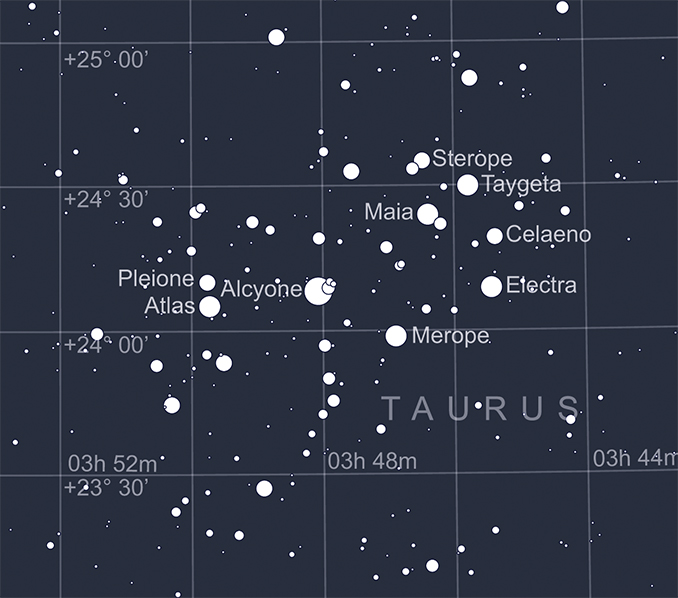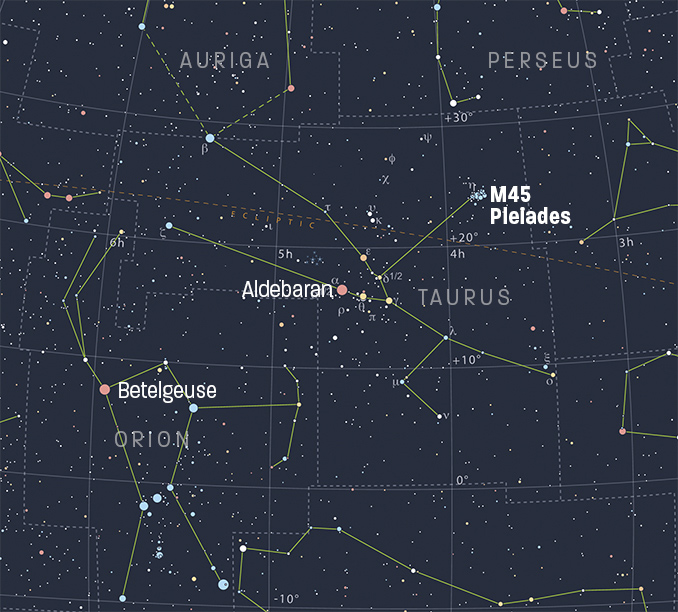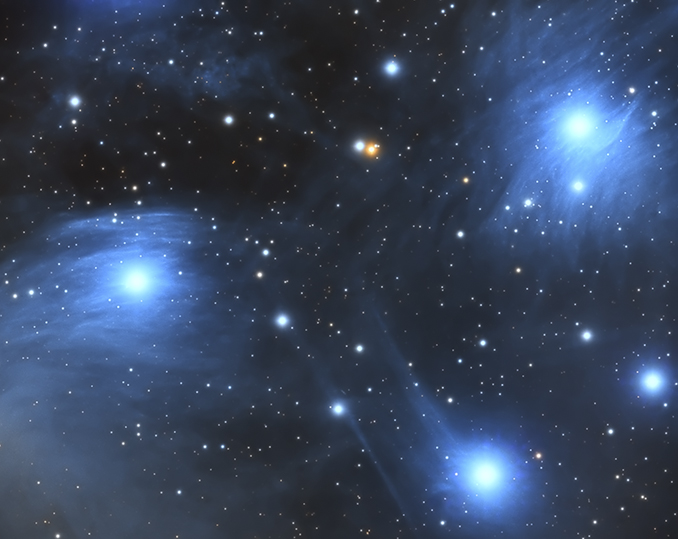
The Pleiades open cluster, or Messier 45, in Taurus is as good as it gets for night-sky eye candy. There are only a handful of deep-sky objects that come close to its fame and sheer majesty. For newbie and experienced observers alike, its impact is not limited in any way: it is easily visible to the naked-eye in most skies and looks superb through a pair of binoculars or a small telescope, while owners of larger telescopes can explore in detail the wispy blue nebulosity that blankets its bright stars and imagers can capture the full depth of its grandeur. Furthermore, on November nights it’s on show for the majority of the long nights, peaking high in the south at the not unreasonably late time of between 11pm and 1am GMT.

Pleiades long history
Charles Messier added the Pleiades as M45, the last object to be included in the first version of his list of deep sky objects published in 1771. Messier first observed the cluster in 1769 but of course the Pleiades has been known since prehistoric times. Every significant culture down the ages has made reference to it, including ancient Chinese annals dating back to 2,357 BC and Mesopotamian mythology even further back. Homer makes reference to it in his Odyssey and it is also mentioned in the Old Testament. The earliest astronomical description of the Pleiades is credited to the Sicillian observer Giovanni Bastista Hodierna, who in 1654 counted a total of 37 Pleiads; Galileo counted 36.

Open clusters: destined to disperse in the blink of a cosmological eye
Open clusters are the products of ongoing star formation in the regions of molecular hydrogen in our Galaxy’s spiral arms and overwhelmingly contain young, hot blue stars, over time scattering due to gravitational forces. Therefore in almost all instances open clusters are relatively young. The Pleiades (Messier 45) is thought to have formed some 125 million years ago and is expected to disperse within the next 250 million years (the nearby Hyades open cluster, the familiar ‘V‘ shape ‘head‘ of the Bull, is estimated to be nearly 800 million years old).
Over 1,400 stars reside within the Pleiades, bound to one another by gravity but moving away from one another fast enough that they will gradually disperse over the next quarter of a billion years, becoming absorbed into the overall mass of the galactic disc. Most of the Pleiads (the name given to the stars in the cluster) are smaller and fainter than our Sun, while a few dozen are hotter B-type stars. It’s this mix of large and small stars, all about the same young age, that provides astronomers with the perfect place to compare and contrast, and to test our understanding of how stars of different masses and luminosities develop.

How to observe
Wait for a moonless and transparent night at a site free from major sources of light pollution and let your eyes become dark adapted for say between 15 and 30 minutes. Look about one-and-a-half fists (a fist held at arms length covers around 10 degrees across the knuckles) to the north-west (upper-right) of magnitude +0.87 ruddy-red Aldebaran (alpha [α] Tauri). The Pleiades is the tight grouping of stars that resembles a mini ‘Plough’. Now the fun begins!
How many individual stars within the cluster can you see? There are in fact ten Pleiads (as individual stars here are often termed) that shine brighter than sixth-magnitude. The five brightest Pleiades — Alcyone (eta [η] Tauri, the brightest Pleiad, Atlas, Electra, Maia, and Merope — range from magnitude +2.9 to +4.2 and should be immediately apparent, but most people report six or seven. The cluster is traditionally known as the Seven Sisters, a reference to ancient Greek mythology, but as many as 14 to 18 Pleiads have been claimed by eagle-eyed individuals!

Hopefully, you’ve brought along a pair of 10 × 50 binoculars. Raise them to your eyes and be amazed! Their field of view easily encompasses the cluster, which, spanning two degrees across or four full moon-widths, is larger in angular extent than many expect. The wonderful view reveals some of the hundreds of fainter stars scattered around the brighter cluster members, including the aforementioned principal stars. A telescope of around 80mm (three inches) in aperture can show around 60 stars, but getting the whole cluster within the field of view can be problematic, even when it’s operating at low power.
Virtually every present-day image of the Pleiades shows it’s substantially swathed in picturesque, wispy-blue nebulosity that’s courtesy of the blue-white light of Messier 45’s young stars being beautifully reflected and scattered by a huge, random dust cloud that the cluster is presently travelling through.
The brightest part of this nebulosity surrounds magnitude +4.1 Merope, the bright star at the southern corner of the ‘Plough’. Designated NGC 1435, a 250mm (ten-inch) telescope is a safe bet to pick it up under typical UK sky conditions.

GRAPHIC] M45 finder
CAPTION] The Pleiades in Taurus can be easily seen with the naked eye and should be familiar to every observer.



